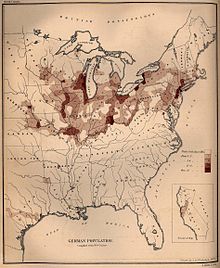German American

As German Americans ( english German Americans ) are citizens of the United States called, or whose ancestors themselves from Germany or as members of German-speaking minorities outside Germany into the United States of America immigrated are. In the American Community Survey carried out in 2015, over 45 million US citizens named “German” as their main ancestry. This makes the German-Americans the largest ethnic group in the United States.
history
The main destination of early German immigration was Pennsylvania . The first German settlement on what is now the United States of America was founded there in 1683: Germantown . The place was founded by the scholar Franz Daniel Pastorius , who arrived here in 1683 together with 13 families - Quakers and Mennonites - from the Krefeld area.
In 1775, one third of the population of Pennsylvania was made up of German-born residents. They were predominantly Lutherans , Reformed , Amish , Mennonites and followers of other Protestant faiths. The German-Americans in Pennsylvania developed their own form of language based on Palatine dialects , the Pennsylvania Dutch , which is still spoken sporadically today. There were other important German settlements in North America during colonial times in New York and Virginia.
Benjamin Franklin was editor of the Philadelphische Zeitung for a short time and in this role developed into a massive opponent of German immigration, because the editor of the newspaper, Johann Christoph Sauer , encouraged immigrants to maintain their cultural and religious independence and to distance themselves from Quakers and relatives the Episcopal Church and other denominations. The Deist Franklin saw in this attitude a dangerous cultural backwardness; he described the German-speaking immigrants, who mostly came from impoverished rural regions of southern Germany and Bohemia, as religious zealots and "boors" (pejorative: Boers , farmers). Many Germans in Pennsylvania refused to allow their children to attend English-speaking schools. Since the mid-1750s the administration and church in Pennsylvania reacted more and more to this tendency to refuse integration . They demanded forced marriage and a ban on the German-language press and the German language in public, which Franklin criticized as excessive. Even Thomas Jefferson and James Madison shared the reservations Franklin against German immigrants, but they used other arguments: German and migrants from other "backward" absolutist countries they saw as a threat to the American culture of freedom and prosperity.
In 1816 there was a famine, especially in southern Germany and Switzerland, due to a cooling of the climate after the year without a summer , which resulted in a wave of emigration.
The largest wave of German immigration occurred between 1848 and World War I , when over six million Germans immigrated to the United States. Most of them came
- for economic reasons,
- because of bad harvests and catastrophic floods,
- because of the population growth in Germany , Austria and Switzerland ,
- because of their beliefs or - like the Forty-Eighters - because of their political commitment or
- to the military service to escape.
The German immigrants of 1848/49 were not discriminated against in many regions - unlike their Pennsylvania predecessors and most non-Europeans (such as the Mexican and Chinese immigrants ). In Texas, for example, they were accepted because of their agricultural techniques and hard work (see also Latin Settlement ). The German immigrants integrated themselves more and more into the young American society and in many cases came to an economic, political, social and cultural influence similar to that of the British immigrants. However, unlike Anglo-American farmers, they mostly only use freelance workers on their cotton fields, which not only earned them sympathy. Again and again there were anti-German (as well as anti-Irish) pogroms , for example at the height of another massive wave of immigration on August 6, 1855 in Louisville (Kentucky) with 22 dead. Much of this unrest also had religious causes. The Germans often violated the Sunday alcohol ban. The anger of the Puritans was increasingly directed at the Catholic immigrants from southern Germany who refused to use the King James Bible , as well as at Catholic migrants from Austria, Italy and Ireland and the Hispanics .
In the 1890s, the pattern of discrimination changed : German speakers as an immigrant group were apparently systematically preferred to Poles from Prussia, for example, or Czechs and Jews from the Habsburg Empire , which was expressed in the demands of the restrictionists for language tests , in which each person had a few sentences in their official language Home country had to rule.
During the First World War , German Americans were suspected of sympathizing with the Central Powers . In some areas, German lessons were banned in 1917/18 and German-language school books were burned. Many German-Americans reacted to this pressure with a demonstrative adjustment to the English cultural “mainstream”.
Another German American migration push took place after the seizure of power of the Nazis from 1933. Many academics left the German Empire, because they could not work there more (about prohibitions ); soon many Germans sought refuge in the USA because their lives in Hitler's Germany were acutely threatened.
Thousands of Germans living in the United States were interned during the Second World War . After the end of the war, many German-Americans in solidarity sent CARE packages to the devastated Germany.
Many Germans are still moving to the USA today. In the meantime, in the place of poverty migration and the flight from persecution, there has been a labor migration, especially of scientists who are looking for more favorable career, working and research conditions in the states than they find in the German-speaking area. The trend seems to be downward. The distinction between “emigration” and a temporary work stay abroad has also become fluid.
Cultural heritage
Americans with German-speaking roots have formed its largest population group since the USA was founded; they made a decisive contribution to the development of an American culture.
Baron von Steuben , a former Prussian officer , led the build-up of the American army in the American War of Independence and thereby made it possible to defeat British troops.
During the National Socialist rule, numerous German, mainly Jewish, scientists and intellectuals immigrated to the United States, including Albert Einstein , Theodor Adorno and Thomas Mann (see list of well-known German emigrants from the USA ). After the Second World War, Wernher von Braun and most of the engineers at the Peenemünde Army Research Center were brought to the United States as part of Operation Overcast , where they worked on the American missile program.
Popular dishes such as frankfurters, hamburgers, bratwurst and strudel are based on the influence of German cuisine . The renaissance of microbreweries was also shaped by German brewers. Another German-American specialty are pretzels , which Julius Sturgis ( Lititz , Pennsylvania , 1861) brought to market for the first time in the USA .
Ohio is known for the German-American Festival Zinzinnati , and New York City , Philadelphia, and other cities host the Steuben Parade , a parade of German-Americans, every year. In addition, German-American festivals and Octoberfests take place across the country . Tens of thousands of American tourists travel to Germany every year to discover the land of their ancestors.
According to the 2000 census, 1,382,610 people used German as their mother tongue ; If you include the speakers of the German dialects, Pennsylvania Dutch and Luxembourgish , the number was 1,467,184 speakers. Of these, 11.9% were between 5 and 17 years old, 64.9% between 18 and 64 and 23.2% were older than 65 years.
German city names in the United States

In most US states there are city foundations by Germans and cities with German names, for example Hamburg (New York) , Munich (North Dakota) , Stuttgart (Arkansas) , Augsburg (Arkansas) , Bismarck (North Dakota) , New Braunfels ( Texas) ), Minden (Nebraska) , Schaumburg (Illinois) , New Berlin (Illinois) , Flensburg (Minnesota) , Frankenmuth (Michigan), Fredericksburg (Texas) , Dresden (Ohio) , New Berlin (Wisconsin) , Kiel (Wisconsin) , New Holstein (Wisconsin), Hanover (Pennsylvania) , Berlin (New Hampshire) , Hanover (New Hampshire) , Paderborn (Illinois) , Karlsruhe (North Dakota) , New Leipzig (North Dakota), New Ulm (Minnesota) , Meppen (Illinois) , New Trier (Minnesota), Bremen (Georgia) , Weimar (Texas) , Bingen (Washington) or Anaheim (California). Numerous Viennas were founded by Austrian immigrants , such as Vienna (Georgia) , Vienna (Virginia) or Vienna (Wisconsin) . New Bern or Bern (Kansas) are examples of Swiss roots.
Facilities for German-Americans
societies
Numerous societies and associations maintain the cultural heritage:
- The German-American Heritage Foundation, founded in Philadelphia in 1977, acts as the umbrella organization .
- The oldest and probably most active society is the German Society of Pennsylvania, founded in Philadelphia in 1764 .
- The German Society of Maryland , based in Baltimore, was founded in 1900.
- The German Society of the City of New York is primarily dedicated to supporting Germans living in New York.
Educational institutions
- Institute for German-American Relations - The institute is an information and discussion center on German-American relations and provides schools with teaching material.
- German Amerikana Collection at the University of Cincinnati
- American Association of Teachers of German, Inc.
- German American Heritage Museum in Washington, DC
Cultural processing
- Johannes Gillhoff : Jürnjakob Swehn the America driver . Evangelical Book Community, Stuttgart 1917. Reprint: BS, Rostock 2006, ISBN 3-89954-219-3 .
See also
literature
- Bernd Brunner : To America. The history of German emigration. CH Beck, Munich 2009, ISBN 978-3-406-59184-6 .
- Alexander Emmerich: Little Germany: German emigrants in North America. Campus, Frankfurt 2019, ISBN 978-3-593-51099-6 .
- Alexander Emmerich: The History of the Germans in America. From 1680 to the present. Torch bearer, Göttingen 2010, ISBN 3-7716-4441-0 .
- Christian Gellinek : Those Damn 'Dutch. The Beginning of German immigration in North America during the Thirty Years' War. Campus, Frankfurt am Main 1996, ISBN 3-593-35452-7 .
- Dirk Hoerder , Jörg Nagler (eds.): People in Transit: German Migrations in Comparative Perspective, 1820–1930. Cambridge University Press, Cambridge 2002, ISBN 978-0-5215-2192-5 .
- Russell A. Kazal: Becoming Old Stock: The Paradox of German-American Identity. Princeton University Press, Princeton 2004, ISBN 978-0-691-05015-7 .
- Don Heinrich Tolzmann: The German-Amerikana Collection at the University of Cincinnati (= Stuttgart theses on German studies. No. 423). Hans-Dieter Heinz, Stuttgart 2004, pp. 447-458, ISBN 3-88099-428-5 .
- Rainer Vollmar: Living in the wild. Settlement design and identity of German emigrants in the USA. Dietrich Reimer, Berlin 1995, ISBN 3-496-02554-9 .
- Rainer Vollmar: Anaheim - Utopia Americana. From wine country to Walt Disney land. A city biography (= geographic knowledge. Issue 126). Franz Steiner, Stuttgart 1998, ISBN 3-515-07308-6 .
- Katja Wüstenbecker: German-American in World War I. US Politics and National Identities in the Midwest. Franz Steiner, Stuttgart 2007, ISBN 978-3-515-08975-3 .
Web links
- U.S. Department of Population Statistics (PDF; 5.9 MB)
- THANKS to the German-American National Congress
Individual evidence
- ^ German-American Heritage Foundation of the USA
- ↑ Newspaper article about the analysis of the Deutsche Rundschau
- ↑ Groups of origin in the United States, according to the US Census Bureau
- ^ First German Settlers in America ; The Palatinate - a country of emigration
- ↑ Simon Schama : The American Future: A History from the Founding Fathers to Barack Obama. 2nd Edition. Vintage, London 2009, p. 241.
- ↑ Schama, 2009, p. 262.
- ↑ Schama, 2009, p. 263 f.
- ↑ Schama, 2009, p. 286 f.
- ^ Using the example of Ohio: Anti-German Sentiments Ran High in 1918. ( Memento from December 22, 2011 in the Internet Archive ) In: Times Reporter (English).
- ↑ Our History. ( Memento of October 7, 2007 in the Internet Archive ) Julius Sturgis. Company website (English).



